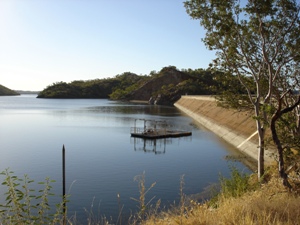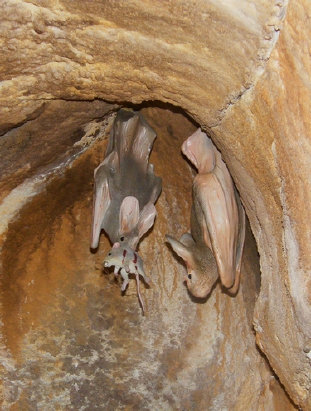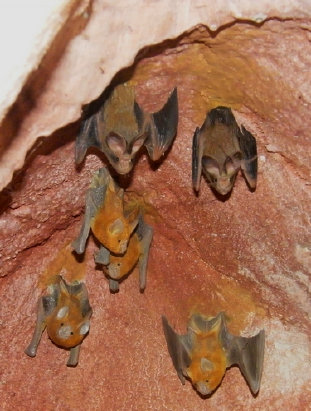Australia So Much to See


On the Leichhardt River 12 miles below
Declared
to be a sanctuary for the purposes of The Fauna Conservation Act of 1952.
Supplies water to
Dam completed September 1957 by Thiess Bros (Qld) Pty Ltd.
Catchment area 430 square miles.
Surface
area 4,859 acres.
Dam capacity 17,389,000,000 gallons or 64,026 acre feet.
Height of dam wall 87 feet, length along crest
850 feet, width across base 230 feet.
Dam wall contains 190,000 cubic yards of rock.
Depth of water at wall when full 68
feet.
Spillway 1,073.25 feet above sea level.
Average rainfall 14.75 inches
Water is pumped 8 miles through a 30 bore
pipeline to the main service reservoir.
Leggadina is another rodent fossil
Large Ghost Bats lived in caves and forests at Riversleigh
Namilamadeta An ancient burrowing marsupial. Remains of this animal are represented in the Miocene deposits at Riversleigh
Thingadonta A strange marsupial from Riversleigh named because of the animals strange teeth configuration
Chelid Turtles closely related to the South American Psuedemydura
Neohelos A medium sized browsing marsupial roughly the size of a modern sheep
Balungamayine A now extinct wallaby sized kangaroo richly represented in the late Miocine deposits
Musy Rat Kangaroo related to todays Musky Rat Kangaroo
Wakaleo An ancient marsupial lion
Zyzomys was a rock rat which lived in caves and rocky areas
Pseudomys known as a false mouse
Sheath-tailed Bats and Horseshoe Bats - were common prey for the much larger Ghost Bat
Wattle Bat a small insect eating bat
Phascogale A small carnivorous marsupial. These animals can still be found in forest areas of
Procoptodon A giant short faced kangaroo species which survived until about 20,000 years ago
Megalania Prisca the largest known land dwelling lizard which reached lengths of over five metres
Diprotodons This rhinoceros sized herbivore was the largest known marsupial anywhere in the world
Pallimnarchus was a large freshwater crocodile not closely related to any modern
Species of Yurlunggur are the largest snakes found in the Riversleigh fossil deposits (up to six metres long), and also occur at other
localities in northern and eastern
Yurlunggur is derived from the name of a Rainbow Serpent in the Yolngu language of
Fossil facts: From Riversleigh, Triolabites date to 500 million years ago, and vertebrates from 26 million years to current. Most are ancestors of present animals; eg kangaroos, ghost bats, snakes, platypus, turtles and rodents. Vertebrate species
usually become extinct within two million years.
There are living species of Emydura in most of the river systems of eastern and northern
War Fears and Spy Games
With the bombing of
The Australian newspaper said reports commissioned by five Mount Isa families who are suing mining giant Xstrata, the state government and the local council, were the first scientific evidence of the effect on children of lead pollution from the town's mine and smelters.
Theodore Lidsky, an adjunct professor of neuroscience at New York's City University, focused on the two worst cases of lead poisoning.
The first was five-year-old Sidney Body, who had a blood lead level of 31.5 micrograms per decilitre three times the international safety limit.
The second case was that of four-year-old Bethany Sanders, who had a blood lead level of 27.4.
Professor Lidsky found both had brain damage and the only explanation was lead poisoning.
The newspaper said that despite a crackdown on mine emissions and education on how to limit exposure after testing in 2008 found 11 per cent of Mount Isa's children aged one to four had dangerously high blood lead levels about five per cent still had unsafe levels.
Lead exposure leads to brain damage Article no longer available. See more on WHO - Lead Poisoning and Health.
Mining emissions causing lead poisoning in children
Xstrada mining operations in Mount Isa Updated link
2022: The mother of a 16-year-old Queensland girl with an intellectual disability is suing mining company Mount Isa Mines for $5 million in damages, alleging her daughter's brain damage is the result of lead poisoning caused by emissions from the mine site. Queensland's Mount Isa Mines faces $5m lawsuit over allegations lead poisoning caused teenager's brain damage.
August 2023: See news report. The above case against Glencore was unsuccessful, with judgement stating

Use your browser back button to return to the page you were reading

